Rosary: Mystery Reflections
Rosary Meditations Based on the Catechism of the Catholic Church
On October 7, the Catholic Church celebrates a memorial liturgy in honor of Mary as Our Lady of the Rosary. October has also been traditionally known as the month of the Rosary. The recitation of the Rosary is a devotion based on Sacred Scripture. In 1974, Pope Paul VI wrote about the Rosary:
The Rosary draws from the Gospel the presentation of the mysteries and its main formulas . As it moves from the angel's joyful greeting and the Virgin's pious assent, the Rosary takes its inspiration from the Gospel to suggest the attitude with which the faithful should recite it. In the harmonious succession of Hail Marys, the Rosary puts before us once more a fundamental mystery of the Gospel--the incarnation of the Word, contemplated at the decisive moment of the Annunciation of Mary. The Rosary is thus a Gospel prayer, as pastors and scholars like to define it, more today perhaps than in the past. (Marialis Cultus 44)
We are pleased to present a meditation of the Joyful, Luminous, Sorrowful, and Glorious mysteries in image and text from two cloistered Dominican monasteries. The artist and the author have creatively approached the Rosary devotion in our contemporary world. Both have given us permission to publish their works. (For more information, see below). We invite you to take a quiet moment and ponder the images and texts. Recently, Sr. Mary Grace Thul completed the illustrations of the new series of mysteries, the mysteries of light. the accompanying texts are taken from John Paul II's letter on the Rosary.
Joyful Mysteries | Luminous Mysteries | Sorrowful Mysteries | Glorious Mysteries
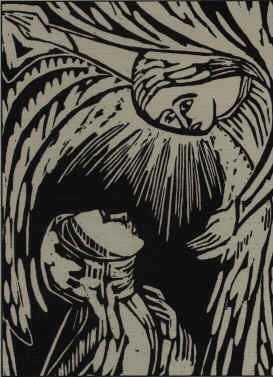
The Annunciation
At the announcement that she would give birth to "the Son of the Most High" without knowing man, by the power of the Holy Spirit, Mary responded with the obedience of faith, certain that "with God nothing will be impossible:" "Behold, I am the handmaid of the Lord; let it be done to me according to your word." Thus, giving her consent to God's word, Mary becomes the mother of Jesus. Espousing the divine will for salvation wholeheartedly, without a single sin to restrain her, she gave herself entirely to the person and to the work of her Son; she did so in order to serve the mystery of redemption with him and dependent on him, by God's grace.
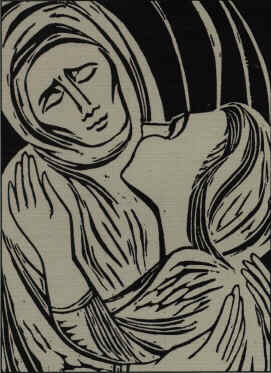
The Visitation
Called in the Gospels "the mother of Jesus," Mary is acclaimed by Elizabeth, at the prompting of the Spirit and even before the birth of her son, as "the mother of my Lord." In fact, the One whom she conceived as man by the Holy Spirit, who truly became her Son according to the flesh, was none other than the Father's eternal Son, the second person of the Holy Trinity. Hence the church confesses that Mary is truly "Mother of God" (Theotokos).
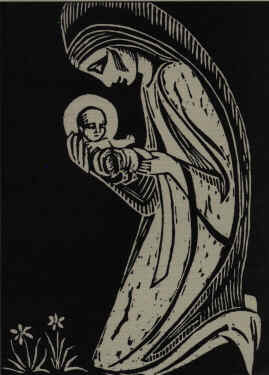
The Birth of the Lord
The Word became flesh so that thus we might know God's love:"In this the love of God was made manifest among us, that God sent his only Son into the world, so that we might live through him." "For God so loved the world that he gave his only Son, that whoever believes in him should not perish but have eternal life.
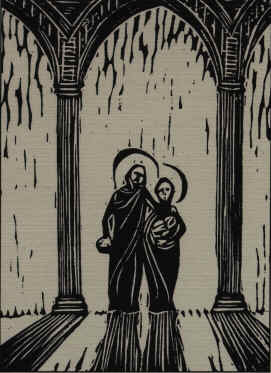
The Presentation in the Temple
The presentation of Jesus in the temple shows him to be the firstborn Son who belongs to the Lord. With Simeon and Anna, all Israel awaits its encounter with the Savior--the name given to this event in the Byzantine tradition. Jesus is recognized not only as the long-expected Messiah, the "light to the nations" and the "glory of Israel," but also as "a sign that is spoken against." The sword of sorrow predicted for Mary announces Christ's perfect and unique oblation on the cross that will impart the salvation God had "prepared in the presence of all peoples."
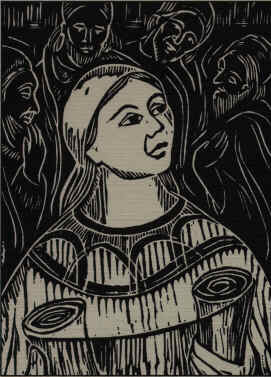
The Finding in the Temple
The finding of Jesus in the temple is the only event that breaks the silence of the Gospels about the hidden years of Jesus. Here Jesus lets us catch a glimpse of the mystery of his total consecration to a mission that flows from his divine sonship: "Did you not know that I must be about my Father's work?" Mary and Joseph did not understand these words, but they accepted them in faith. Mary "kept all these things in her heart" during the years Jesus remained hidden in the silence of an ordinary life.
In Marialis Cultus (1974), Pope Paul VI proposed principles for the renewal of Marian devotion, speaking at length on the Rosary. Since that time, practical suggestions have come from a number of groups.
The German Liturgical Institute was eventually asked its opinion about instituting a fourth series of Rosary mysteries, The Public Life of Jesus. A Marian group in Leutsdorf, Germany then requested permission to officially institute a fourth series of mysteries that had been suggested by Rev. Benno Mikocki of Vienna, the head of the Rosary/Reparation Way of the Cross movement.
The letter of the Liturgical Institute noted that an attempt had been made to promote these mysteries over twenty years ago in the national German prayerbook, Gotteslob. This attempt had found little echo from the people. The letter indicated that such devotions have to come from among the people rather than "from the top down." Dr. Elmar Nubold, director of the Liturgical Institute, commented that the three sets of mysteries, with their concise formulations, had proven effective over the years. Nevertheless, new suggestions should be taken into account. Rev. Josef Schultheiss concluded from the Liturgical Institute's response that it was now up to the individual communities and movements to do what they could to further this intention in order to achieve their aim over a longer period of time.
In Rosarium Virginis Mariae (2002), John Paul II proposed the Luminous mysteries below as an "addition to the traditional pattern." (RVM, 19)
The mysteries of light are placed between the Joyful and sorrowful mysteries. Each one of the Luminous mysteries sheds light on an important aspect of Christ's mission: He is son of the Father, the miracle worker, announcer of the Kingdom, the transfigured Son of god, and living bread or Eucharistic presence. He is God's light for this world. These new mysteries are extensively treated in John Paul II's letter on the rosary.
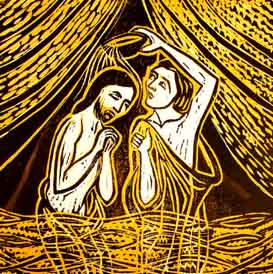
The Baptism of the Lord in the Jordan
Then Jesus came from Galilee to the Jordan to John, to be baptized by him. John tried to refuse him with the protest, "I need to be baptized by you, and yet you come to me!" Jesus answered him, "Give in for now; we must do this if we are to fulfill all of God's demands." So John gave in. After Jesus was baptized, he came directly out of the water. Suddenly, the sky opened and he saw the Spirit of God descend like a dove, and hover over him. With that, a voice from the heavens said, "This is my beloved Son. My favor rests on Him." The Baptism in the Jordan is first of all a mystery of light. Here, as Christ descends into the waters, the innocent one who became 'sin' for our sake (cf. 2Cor 5:21), the heavens open wide and the voice of the Father declares him the beloved Son (cf. Mt 3:17 and parallels), while the Spirit descends on him to invest him with the mission which he is to carry out. (RVM, 21)
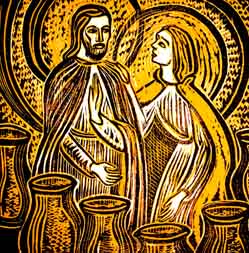
The Self-revelation of the Lord at the Wedding Feast of Cana
The second mystery of light is the first of the signs, given at Cana (cf. Jn 2:1- 12), when Christ changes water into wine and opens the hearts of the disciples to faith, thanks to the intervention of Mary, the first among believers. He reveals himself as Lord and miracle worker.
In the mystery of light, apart from the miracle at Cana, the presence of Mary remains in the background. The Gospels make only the briefest reference to her occasional presence at one moment or other during the preaching of Jesus (cf. Mk 3:31-5; John 2:12), and they give no indication that she was present at the Last Supper and the institution of the Eucharist. Yet the role she assumed at Cana in some way accompanies Christ throughout his ministry. The revelation made directly by the Father at the Baptism in the Jordan and echoed by John the Baptist is placed upon Mary's lips at Cana, and it becomes the great maternal counsel which Mary addresses to the Church of every age: "Do whatever he tells you." (Jn 2:5) This counsel is a fitting introduction to the words and signs of Christ's public ministry and it forms the Marian foundation of all the 'mysteries of light'. (RVM, 21)
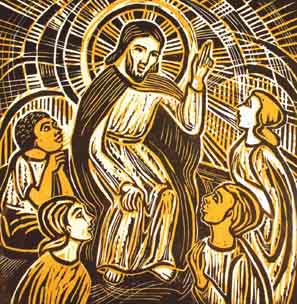
The Lord Jesus Proclaims the Coming of the Kingdom
After John's arrest, Jesus appeared in Galilee proclaiming the good news of God. "This is the time of fulfillment. The reign of God is at hand! Reform your lives and believe in the Gospel!" Another mystery of light is the preaching by which Jesus proclaims the coming of the Kingdom of God, calls to conversion (cf. Mk 1:15) and forgives the sins of all who draw near to him in humble trust (cf. Mk 2:3-13; Lk 7:47- 48): the inauguration of that ministry of mercy which he continues to exercise until the end of the world, particularly through the Sacrament of Reconciliation which he has entrusted to his Church. (cf. John 20:22-23) (RVM, 21)
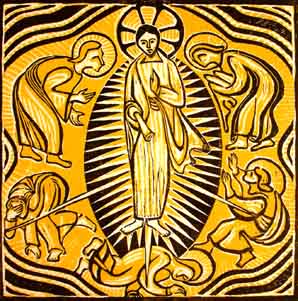
The Transfiguration of Our Lord
About eight days after saying this, he took Peter, John, and James, and went up onto a mountain to pray. While he was praying, his face changed in appearance and his clothes became dazzling white. Suddenly two men were talking with him, Moses and Elijah. They appeared in glory and spoke of his passage, which he was about to fulfill in Jerusalem. Peter and those with him had fallen into a deep sleep; but awakening, they saw his glory and likewise saw the two men who were standing with him. When these were leaving, Peter said to Jesus, "Master, how good it is for us to be here. Let us set up three booths, one for you, one for Moses, and one for Elijah." (He did not really know what he was saying.) While he was speaking, a cloud came and overshadowed them, and the disciples grew fearful as they entered it. Then from the cloud came a voice which said, "This is my Son, my Chosen One. Listen to him." When the voice fell silent, Jesus was there alone. The disciples kept quiet, telling nothing of what they had seen at that time to anyone. The mystery of light par excellence is the Transfiguration, traditionally believed to have taken place on Mount Tabor. The glory of the Godhead shines forth from the face of Christ as the Father commands the astonished Apostles to 'listen to him' (cf. Lk 9:35 and parallels) and to prepare to experience with him the agony of the Passion, so as to come with him to the joy of the Resurrection and a life transfigured by the Holy Spirit. (RVM, 21)
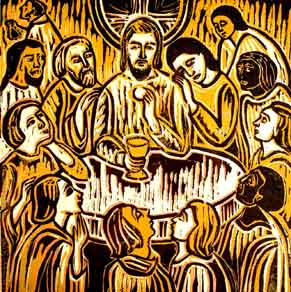
The Institution of the Eucharist
During the meal Jesus took bread, blessed it, broke it, and gave it to his disciples. "Take this and eat it," he said. "This is my body." Then he took a cup, gave thanks, and gave it to them. "All of you must drink from it," he said, "for this is my blood, the blood of the covenant, to be poured out in behalf of many for the forgiveness of sins. I tell you, I will not drink this fruit of the vine from now until the day when I drink it new with you in my Father's reign." Then, after singing songs of praise, they walked out to the Mount of Olives. A final mystery of light is the institution of the Eucharist, in which Christ offers his body and blood as food under the signs of bread and wine, and testifies 'to the end' his love for humanity (Jn 13:1), for whose salvation he will offer himself in sacrifice. (RVM, 21)
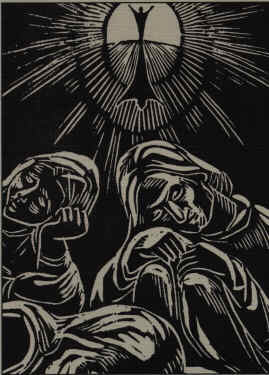
The Agony in the Garden
The cup of the New Covenant, which Jesus anticipated when he offered himself at the Last Supper, is afterwards accepted by him from his Father's hands in his agony in the garden at Gethsemani, making himself "obedient unto death." Jesus prays: "My Father, if it be possible, let this cup pass from me...." Thus he expresses the horror that death represented for his human nature. Like ours, his human nature is destined for eternal life, but unlike ours, it is perfectly exempt from sin, the cause of death. Above all, his human nature has been assumed by the divine person of the "Author of life, the living One." By accepting in his human will that the Father's will be done, he accepts his death as redemptive, for "he himself bore our sins in his body on the tree."
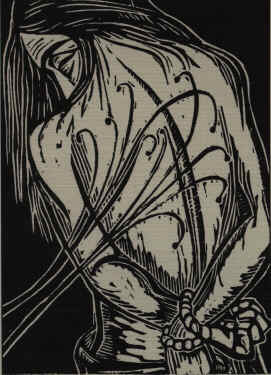
The Scourging
Jesus knew and loved us each and all during his life, his agony, and his Passion and gave himself up for each one of us: "The Son of God...loved me and gave himself for me." He has loved us all with a human heart For this reason, the Sacred Heart of Jesus, pierced by our sins and for our salvation, "is quite rightly considered the chief sign and symbol of that...love with which the divine Redeemer continually loves the eternal Father and all human beings" without exception.
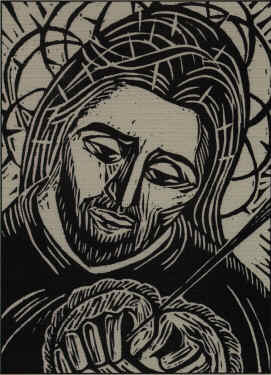
Jesus Is Crowned with Thorns
It is precisely in the Passion, when the mercy of Christ is about to vanquish it, that sin most clearly manifests its violence and its many forms: unbelief, murderous hatred, shunning and mockery by the leaders and the people, Pilate's cowardice and the cruelty of the soldiers, Judas' betrayal so bitter to Jesus, Peter's denial, and the disciples' flight. However, at the very hour of darkness, the hour of the prince of this world, the sacrifice of Christ secretly becomes the source from which the forgiveness of our sins will pour forth inexhaustibly.
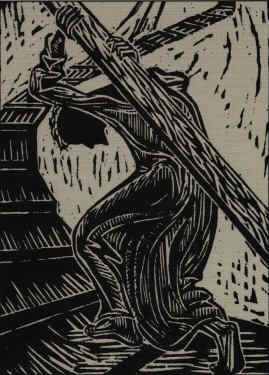
The Carrying of the Cross
The cross is the unique sacrifice of Christ, the "one mediator between God and men." But because in his incarnate divine person he has in some way united himself to every man, "the possibility of being made partners, in a way known to God, in the paschal mystery" is offered to all people. He calls his disciples to "take up their cross and follow him," for "Christ also suffered for us, leaving us an example so that we should follow in his steps." In fact Jesus desires to associate with his redeeming sacrifice those who were to be its first beneficiaries. This is achieved supremely in the case of his mother, who was associated more intimately than any other person in the mystery of his redemptive suffering.

The Crucifixion
The Church is born primarily of Christ's total self-giving for our salvation, anticipated in the institution of the Eucharist, and fulfilled on the cross. "The origin and growth of the Church are symbolized by the blood and water which flowed from the open side of the crucified Jesus." "For it was from the side of Christ as he slept the sleep of death upon the cross that there came forth the 'wondrous sacrament of the whole Church.' " As Eve was formed from the sleeping Adam's side, so the Church was born from the pierced heart of Christ hanging dead on the cross.

The Resurrection
Christ's Resurrection and the risen Christ himself is the principle and source of our future resurrection: "Christ has been raised from the dead, the first fruits of those who have fallen asleep.... For as in Adam all die, so also in Christ shall all be made alive." The risen Christ lives in the hearts of his faithful while they await that fulfillment. In Christ, Christians "have tasted...the powers of the age to come" and their lives are swept up by Christ into the heart of divine life, so that they may "live no longer for themselves but for him who for their sake died and was raised."

The Ascension
When his visible presence was taken from them, Jesus did not leave his disciples orphans. He promised to remain with them until the end of time; he sent them his Spirit. As a result communion with Jesus has become, in a way, more intense: "By communicating his Spirit, Christ mystically constitutes as his body those brothers of his who are called together from every nation."

The Descent of the Holy Spirit
The mission of Christ and the Holy Spirit is brought to completion in the Church, which is the Body of Christ and the Temple of the Holy Spirit. This joint mission henceforth brings Christ's faithful to share in his communion with the Father in the Holy Spirit. The Spirit prepares men and goes out to them with his grace, in order to draw them to Christ. The Spirit manifests the risen Lord to them; recalls his word to them and opens their minds to the understanding of his Death and Resurrection. He makes present the mystery of Christ, supremely in the Eucharist, in order to reconcile them, to bring them into communion with God, that they may "bear much fruit."

The Assumption of Our Lady into Heaven
"This motherhood of Mary in the order of grace continues uninterruptedly from the consent which she loyally gave at the Annunciation and which she sustained without wavering beneath the cross, until the eternal fulfillment of all the elect. Taken up to heaven she did not lay aside this saving office but by her manifold intercession continues to bring us the gifts of eternal salvation.... Therefore the Blessed Virgin is invoked in the Church under the titles of Advocate, Helper, Benefactress, and Mediatrix."

The Coronation of Our Lady
The "splendor of an entirely unique holiness" by which Mary is "enriched from the first instant of her conception" comes wholly from Christ: she is "redeemed, in a more exalted fashion, by reason of the merits of her Son." The Father blessed Mary more than any other created person "in Christ with every spiritual blessing in the heavenly places" and chose her "in Christ before the foundation of the world, to be holy and blameless before him in love."
Acknowledgments:
English translation of the Catechism of the Catholic Church for the United States of America, copyright 1994, United States Catholic Conference, Inc. Libreria Editrice Vaticana. Used with permission.
Scripture quotations are adapted from the Revised Standard Version of the Bible © 1946, 1952, 1971, and the New Revised Standard Version of the Bible, © 1989, by the Division of Christian Education of the national Council of the Churches of Christ in the U.S.A.
Excerpts from Vatican Council II: The Conciliar and Post Conciliar Documents, New Revised Edition edited by Austin Flannery, OP, © 1992. Costello Publishing Company, Inc., Northport, NY.
Dominican Nuns, Monastery of Our Lady of the Rosary, 335 Doat Street, Buffalo, NY 14211-2199.
All About Mary includes a variety of content, much of which reflects the expertise, interpretations and opinions of the individual authors and not necessarily of the Marian Library or the University of Dayton. Please share feedback or suggestions with marianlibrary@udayton.edu.
